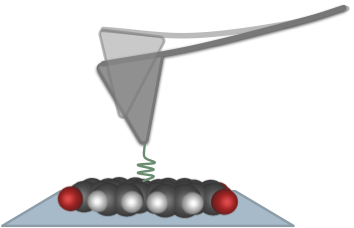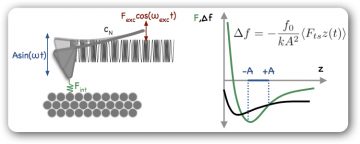AFM is a scanning probe technique that allows for the imaging of conducting, semiconducting, and insulating surfaces. AFM relies on force interactions between the tip and sample. An extremely sharp tip is attached to a cantilever, as opposed to a rigid tip in STM, and is raster scanned across the surface. The signal obtained is directly proportional to the force between tip and sample. In contact mode, the deflection of this cantilever is measured as it moves across the surface. In our lab, we use non-contact mode (NC-AFM), where the tip is oscillated and this change oscillation is detected. In order to simultaneously perform AFM and STM a “tuning fork” type NC- AFM tip is used.[1]


As the tip interacts with the surface, the resonant frequency, fο, of the tip-sample system is altered. The resonance frequency is tracked, with the cantilever driven at the new resonant frequency, and this frequency shift is measured as a signature of the tip-sample interaction. The frequency shift, df, is proportional to the force gradient in the small amplitude limit.

There are three main forces that contribute to this interaction: electrostatic and van der Waals (long range) and chemical (short range). The signal obtained is the sum of these forces. At very short tip-sample distances, the short ranged forces dominate, allowing for high resolution of the surface features. Surfaces can be imaged with atomic[2], molecular[3] and submolecular[4] resolution. Individual bonds within a molecule have been imaged with NC-AFM.[4] This technique allows for complimentary contrast mechanisms to STM. Simultaneous AFM and STM measurements give both electronic and structural information about the surface.
[1] Omicron NanoTechnology GmbH, “Low temperature AFM and STM technology.” <http://www.omicron.de/en/products/low-temperature-spm/instrument-concept>
[2] Barth, C. and Reichling, M. Imaging the atomic arrangements on the high-temperature reconstructed alpha-Al2O3(0001) surface. Nature 414, 54-57 (2001).
[3] Burke, S. A., Mativetsky, J. M., Hoffmann, R., and Grutter, P. Nucleation and submonolayer growth of C60 on KBr. Phys. Rev. Lett. 94, 096102 (2005).
[4] Gross, L., Mohn, F., Moll, N., Liljeroth, P., and Meyer, G. The chemical structure of a molecule resolved by atomic force microscopy. Science 28 1110-1114 (2009).